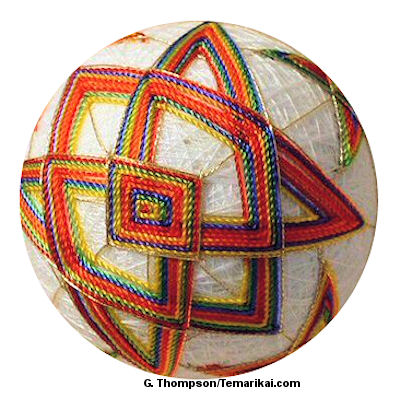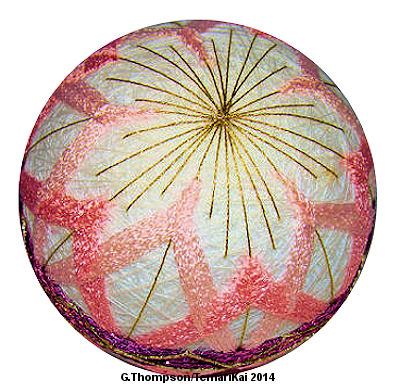Mawashi, Renzoku Stitching or Styles - Continuous Stitching
"Continuous Stitching" is a style found in temari making. It refers to motifs that follow a path to create a design that ends back where it began, but does not include simple polygons. There are several types of continuous stitching styles, each of which have different criteria.
One type is Mawashi Kagari, which may also be referred to as Hitohude Gake (remember, both kagari and gake mean "stitch"). The
 terms are
used interchangeably in the Japanese books, and it basically depends on
the author. Mawashi/Hitohude refer to motifs that are created by using
one thread to create a figure without following the same line twice and
with no starts or stops until returning to the starting point. However,
this does not include simple polygons (that
is, squares, triangles, etc). Very often mawashi/hitohude motifs are
kousa style, since the thread usually crosses its path in the process
and thus interweaves. There is a subtle difference between mawashi and
hitohude, however. Mawashi signals smaller motifs worked worked around
one face of a marking. Hoshi kagari
and mitsubane kikkou are two
examples; so is pattern GT37
(interpreted from Japanese books), shown in the photo to the right.
terms are
used interchangeably in the Japanese books, and it basically depends on
the author. Mawashi/Hitohude refer to motifs that are created by using
one thread to create a figure without following the same line twice and
with no starts or stops until returning to the starting point. However,
this does not include simple polygons (that
is, squares, triangles, etc). Very often mawashi/hitohude motifs are
kousa style, since the thread usually crosses its path in the process
and thus interweaves. There is a subtle difference between mawashi and
hitohude, however. Mawashi signals smaller motifs worked worked around
one face of a marking. Hoshi kagari
and mitsubane kikkou are two
examples; so is pattern GT37
(interpreted from Japanese books), shown in the photo to the right. The word hitohude comes to temari from the technique in calligraphy brush painting (brought to Japan from China) where a whole character is painted with one stroke, not lifting the brush from the paper.
Renzoku Kagari is "even more continuous", in a manner of speaking. They can be very subtle patterns to discern as optically they often appear to be more intricate designs worked in individual rounds of shapes. Renzoku involves working
 a design with
one thread, that travels around the circumference of the mari and both
hemispheres as the kagari of the path are taken. It may also step to the
next marking line as part of the path (think of a spirograph-type path,
where the pen had to trace all through the design to return to the
starting point). It may be the path that another stitch follows, or it
may have its own non-defined path. A very simple illustration of a
renzoku application is seen in pattern GT10.
This is an interpretation of a popular pattern in Japanese books, that
uses jyouge douji and a
variation of uwagake chidori
kagari to create a sakura image in the white space on the north
and south poles. It's worked on a simple 10 division, but the
orientation of the stitching requires that for each single row, you must
travel around the ball twice (stitching from north to south to north) in
order to arrive back at your starting point. Stitching occurs on every
3rd line, which is not a multiple of 10, so it requires 21 lines (2
times the 10 of the simple, plus 1 to the starting point) to evenly
circumscribe the ball.
a design with
one thread, that travels around the circumference of the mari and both
hemispheres as the kagari of the path are taken. It may also step to the
next marking line as part of the path (think of a spirograph-type path,
where the pen had to trace all through the design to return to the
starting point). It may be the path that another stitch follows, or it
may have its own non-defined path. A very simple illustration of a
renzoku application is seen in pattern GT10.
This is an interpretation of a popular pattern in Japanese books, that
uses jyouge douji and a
variation of uwagake chidori
kagari to create a sakura image in the white space on the north
and south poles. It's worked on a simple 10 division, but the
orientation of the stitching requires that for each single row, you must
travel around the ball twice (stitching from north to south to north) in
order to arrive back at your starting point. Stitching occurs on every
3rd line, which is not a multiple of 10, so it requires 21 lines (2
times the 10 of the simple, plus 1 to the starting point) to evenly
circumscribe the ball. As mentioned above, all 3 terms have come to be used interchangeably. Mawashi is not too common; more often hitohude will be seen. Renzoku is used as well, but technically refers to going around the full circumference of the mari several times before returning to the starting point.
This
is a TemariKai.com Printable Page; © 2014, all rights reserved.
Right click to print one copy for personal use.
Last updated 1/2014 © 1998 - 2014 TemariKai.com, G. Thompson/PuffinStuff, Inc.
